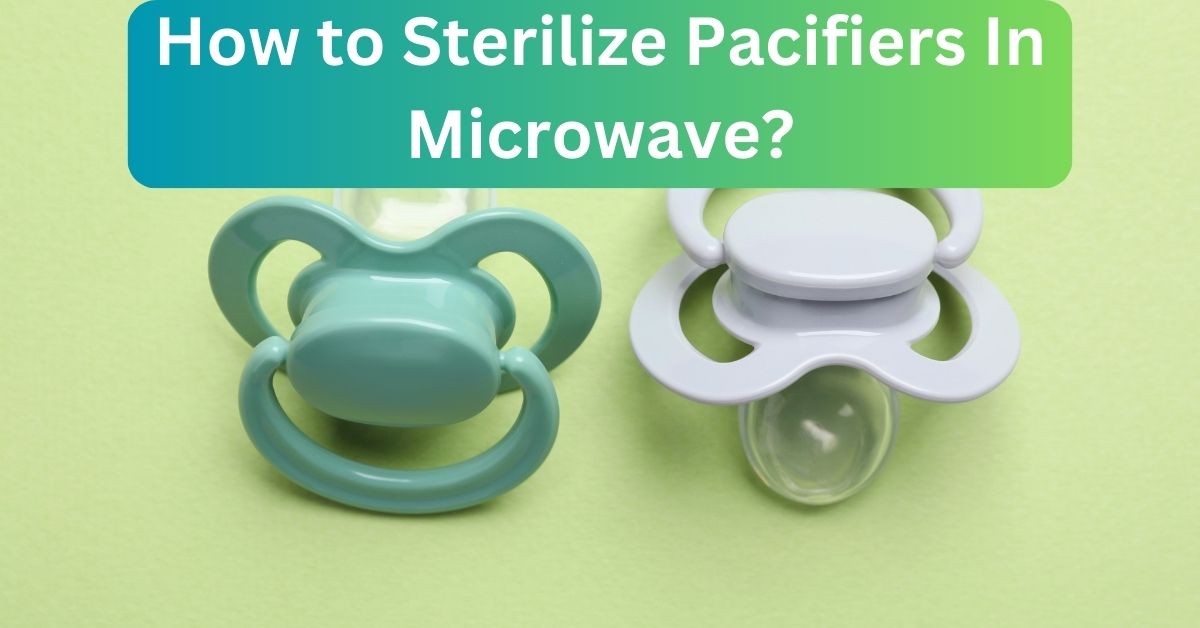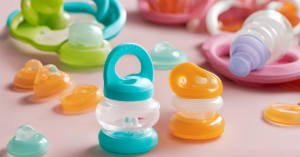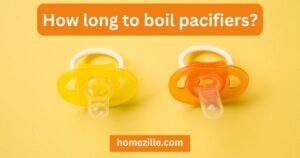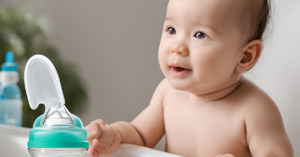Pacifiers are a great way for babies and young children to feel better. Besides making
them feel better when they cry, pacifiers also help them feel better when they are teething. But the hard plastic that is usually used for these things can hold harmful bacteria if it is not cleaned properly.One easy way to keep your baby’s pacifier nice and fresh is to put it in the microwave for a few minutes.
There are a lot of individuals who don’t know how to clean pacifiers in the microwave properly. It’s not difficult at all.Most people use the microwave to reheat fast food, but can it even be used to clean
pacifiers? Pacifiers are small, so it’s easy to put them in a microwave cup without stopping the heat from going everywhere.
But if your pacifier has any plastic pieces, you should take these plastic pieces out first because they could melt and make toxic fumes. Many experts say that the microwave is the best place to kill germs on pacifiers. The pacifier is heated by the microwave until it boils, which is how the appliance works.
At this temperature, the vast majority of bacteria and fungus will be eliminated.Once sterilizing your baby’s Mam pacifier inside this microwave, you must obey the manufacturer’s guidelines. You should also sterilize pacifiers even if they are brand-new and have never been used by your child. Here is how you can sterilize your child’s binky using your microwave oven.
Table of Contents
Importance of Sterilizing Pacifier:
When it comes to raising a child, the use of pacifiers is essential. They aid in the relaxation, sleep and softening of your baby’s gums. They can, however, be a great reservoir of harmful bacteria as well. Before giving pacifiers to your child, make sure that the pacifier is properly sanitized and is free of germs.
Using a pacifier increases the risk of germ transmission from one baby to the next, since germs can be transferred from hands to mouth. To put it another way, if you do not properly sterilise pacifiers, your kid runs the danger of getting various health problems.
You may sterilize the pacifiers by heating them in the microwave if that is your preference. You won’t need more than a few moments to do this task. It is super easy!
The pacifier should be sterilized daily if it is used by a four months baby. As far as sterilization goes, boiling the pacifier is preferred by some parents while microwaving it is preferred by others.
Sterilization Tips:
Parenting was a magazine for families and it was published in United States between 1987 and 2013. Its final headquarters was in Winter Park, Florida. According to “Parenting” magazine you might not have to sterilize bottles and pacifiers daily, but you still have to clean them 24 hours a day. Every time you use a bottle or pacifier, make sure to clean it thoroughly with soap and water, either in the microwave or by hand.
How to Sterilize Pacifiers in Microwave?
You can quickly and easily get rid of any bacteria that may be hiding in a pacifier by putting it in the microwave to sterilize it. Only use this method of sterilization if the pacifier falls to the ground or comes into contact with something dirty.
Place the pacifiers you want to sterilize in a container that can be heated in the microwave, and then proceed with the steps that follow:
Step 1: Place the pacifier in a bowl of water:
To begin, fill a microwave-safe bowl halfway with water and place it in the oven. A plastic or glass bowl can be used to sterilize the Pacifier by dipping it into the water in the bowl.
Step 2: Microwave the pacifier for one minute on high:
The next step is to set your Microwave to high and switch it on, with a 1-minute timer. Your microwave oven’s Microwave mode must be selected, not Fluid flow or any other setting.
Step 3: Cooling the Pacifier:
Now, when the task is completed and thus the Microwave Oven buzzes. You need tongs to get the pacifier out of the oven. The pacifier should not be removed from the microwave until it has reached room temperature.
Step 4: Keep the pacifier in a Cool and Dry Surface:
Keep the Pacifier on a cooler surface to keep it safe from contamination now that it has been sterilized. This pacifier is ready for your baby right now. The next time it comes into contact with a surface, you must continue the cycle again to keep it germ-free.
Are Mam Pacifiers safe to put in the Microwave?
Yes, MAM pacifiers are microwave safe. Microwave it for the recommended period of time once you have re-attached the pacifier’s shield and it has been sanitised. Allow the dummy to air dry after squeezing out any remaining water or moisture from the teat.
Note: Microwaving is not possible for Mam pacifiers with latex nipples because high temperatures accelerate rubber degradation.
Although latex nipples are natural and more flexible than silicone, still integrity of latex is compromised during microwaving. For instance, if the nipple of your Mam pacifier is exposed to open air for a longer length of time, it may lose its dental properties.
Rubber will become unhygienic and moist due to its organic nature, but most mothers avoid it due to the danger of allergies.
Silicone nipples are resistant to heat and do not degrade as quickly as latex nipples. On the other hand, they do not have the same degree of elasticity or resistance to biting as rubber does, and the teat holes are more likely to develop fractures or leak. Before placing a binky in your baby’s mouth, it is essential that you thoroughly inspect each one after washing or sterilizing.
How to Sterilize MAM Pacifiers In Microwave?
Follow These Steps to Properly Sanitize Your Mam Pacifier in the Microwave.You need to submerge a Mam pacifier in the boiling water before using it for the first time. The majority of MAM pacifier types have a sterilizing container made of plastic. These sterilizing casings may be heated up in the microwave without losing their quality.
Precaution: You will notice instructions that instruct you to fill this sterilizer with water and place the pacifier inside with the nipple pointing in the other way.
There are two strategies that are advised for use while sterilizing a pacifier in a microwave.
Method#1
In the first method, a glass container or dish that can be sterilized in the microwave is used.
● Water should be poured halfway in a bowl or a container made of glass.
● Put a Mam pacifier that has already been cleaned in the water.
● Start the microwave oven and let it run at full power for one or two minutes.
● Run for an additional two minutes once you have flipped the dummy over to the other side.
Method#2
In the second method, the pacifier’s own casing is used to place it in the microwave. When
utilising a Mam sterilizing case, the microwaving method remains the same. However, the manufacturer dictates the procedure to be followed. Putting your baby’s pacifier in its sterilizer container and microwaving it will include the following steps:
● Put in the container 0.9 ounces by volume of sterile water.
● Put the MAM pacifier that has already been washed into the container that is also used for sterilizing.
● For roughly three minutes, operate your microwave oven at 750 to 1000 watts of power.
● Five minutes should be enough time for your Mam pacifier to cool while it is still submerged in the water.
● Take the pacifier out of its casing, either by removing or pouring out the water, and let it air dry.
How Often Should You Sterilize MAM Pacifiers?
Pacifiers have to be cleaned every time they touch the ground or something else. If kept safely, it would be nice to sterilize it at least once every two weeks to keep bacteria from building up. Cleaning your baby’s pacifiers and bottles is an essential step to make sure they are safe to use.
Keep a close eye on your baby’s bottle and pacifier for signs of mold and bacteria. Babies have weak immune systems, so bacteria growth can make them sick in many ways. Over the course of a month, keep an eye out for mold and mildew, and as soon as you see signs of growth, clean them well.
Which Mam Pacifier Is Easier to Keep Clean and Germ-Free?
Depending on the temperature limit specifications, Mam latex pacifiers cannot be regularly cleaned and sterilized in a microwave or dishwasher. The best method for cleaning rubber nipples is to first boil water in the microwave and then add soap. You can also use a cooker for the same purpose if you stop placing the pacifier in the oven.
Your silicone pacifier provides the same level of breast-like fluffiness as a latex teat. Its material has an anti-slip surface that prevents the binky from falling out of your baby’s mouth. For older children, you may wash frequently and sterilize occasionally.
However,it is advisable to keep a supply of clean dummies on hand. Because babies start crawling as they age, maintaining the cleanliness of their pacifier becomes difficult. You should use a sterilized vessel to store thoroughly cleaned and sanitized dummies. This includes using a food container to transport soiled diapers while out and about. Whether the Mam pacifier for your baby is made of rubber or silicone, do not keep it for longer than two months.
Always conduct inspections, such as tugging on the nip or searching for signs of wear and tear. Teats with enlarged or torn holes can pose a danger to your child. When your infant begins to teethe, these examinations will focus on teat looseness or grinding damage.
Warnings:
After drying, take care not to leave the pacifiers out on the drain table for a longer period of time. In between uses, keep the bottle nipples clean and free of dust by storing them in a clean cupboard or drawer. The bottle nipples should not be stored until they have completely dried. Mold can grow on wet nipples.
FAQs
How many seconds should you microwave a MAM pacifier for?
A pacifier can be heated in the microwave for 60 seconds. A majority of pacifier brands follow this rule. The amount of time it takes for the pacifier to take effect varies depending on the manufacturer of the pacifier.
Simply place the pacifier and some water in a container that can be heated in the
microwave and heat it for one minute. Remove the pacifier from the water and allow it to air dry for at least a few minutes before giving it to your child. This will ensure that the pacifier is clean and safe to use.
What may happen if pacifiers are not properly sterilised?
When it comes to the health and safety of your kid, the pacifier is one area in which you should never try to save money by cutting costs. Most babies and children require a pacifier at some point in their lives. They not only soothe and calm the baby, and they also aid in the weaning process.
A baby’s mouth can become infected with harmful bacteria when pacifiers aren’t properly sterilized. Pacifiers that haven’t been cleaned and sterilized are a common cause of diseases in infants.
Since harmful bacteria like Candida can live in pacifiers and cause infection, it is imperative that parents clean and sterilize their children’s pacifiers after each use. In addition, pacifiers should be kept out of the range of children’s pets and siblings in a clean, secure location.
Where do you store sterilized pacifiers?
Sterilized pacifiers can be stored in an airtight Ziploc bag in a dry, germ-free area.
Can you boil MAM pacifiers to sterilize?
Sterilization by boiling the pacifier is possible if the pacifier is highly safe to boil. If the
manufacturer says boiling silicone pacifiers is safe, you can sterilize them using that
method. Although natural rubber pacifiers can be damaged by high temperatures, you can’t boil them.
Conclusion:
Let’s wrap up this post on how to microwave and sterilize Pacifiers!Microwave
sterilization of pacifiers was discussed in this article. I have also covered the most
effective manner to accomplish this task, as well as some safety measures that parents
should take. You should keep a sharp eye on your pacifier while it’s in the microwave
from one of the lower settings. This post’s goal is to help you form an opinion about
sterilizing your baby’s pacifiers after reading this article.




